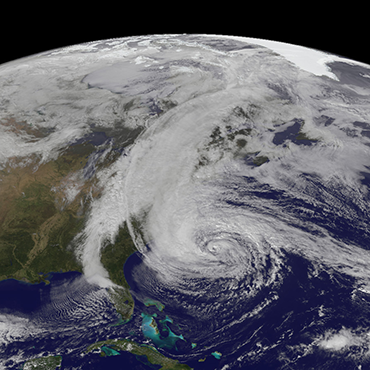Space-based backup guards Weather Service systems

Because even the forecasters of the weather are vulnerable to it, the National Weather Service is escaping the atmosphere altogether.

Superstorm Sandy in 2012. The National Weather Service's facilities and technology are as vulnerable to severe weather as anything else. (NOAA image)
The National Weather Service forecasts the weather, but it's not immune to it.
When disasters like hurricanes, blizzards or tornadoes occur, they can interrupt the continuous flow of meteorological, hydrological, radar and other data from weather forecast offices across the country to NWS headquarters in Silver Spring, Md., where computers process, analyze and distribute that information.
That information is transferred via terrestrial lines, which are not impervious to Mother Nature. So a few years ago, NWS developed a satellite back-up solution for OPSnet, and has now contracted directly with Hughes Networks Systems for that high-flying insurance plan.
If there is an issue somewhere in the terrestrial OPSnet network, information vital to the NWS mission is automatically routed through a fleet of Hughes satellites orbiting 22,500 miles above North America, thereby ensuring continuity of operations.
NWS awarded Hughes a one-year contract worth $1 million with two one-year options to provide the satellite back-up to OPSnet, which began on April 1. The contract replaces one held with another company that ultimately used Hughes satellites for the same purposes.
"The idea is resiliency of information and continuity of operations is extremely important in government, and satellite offers that path," said Tony Bardo, assistance vice president for government solutions at Hughes. "If there is an outage, we take the mission-critical data and traffic in a different direction through the skies to get it to the weather service data center."
The NWS deal with Hughes provides service and remote operational support to 63 existing broadband satellite terminals (VSATs) and a dedicated, redundant IP gateway that includes web acceleration services and proactive network monitoring. Hughes also covers the cost of maintenance, program management and engineering services. The contract provides a slew of services to NWS that could prove of vital importance, considering the severity of the National Oceanic and Atmospheric Administration's 2013 hurricane forecast.
Bardo said satellites offer agencies significant advantages over redundant terrestrial backup systems, and expects more offices to start looking to the skies as opposed to older approaches, like duplicate connections operated by two separate carriers.
Satellites offer higher availability and diversity, and, as Bardo said, a fleet of satellites orbiting high above the atmosphere is never at risk for weather- or ground-based natural disasters like floods, hurricanes or even earthquakes.
"You only need to look as far back as Superstorm Sandy to see how something breaks that continuity," Bardo said. "Businesses need to keep the cash registers running, and in the public sector, the worst time to be out of service is when citizens need them most."
NEXT STORY: Who gets performance information?



